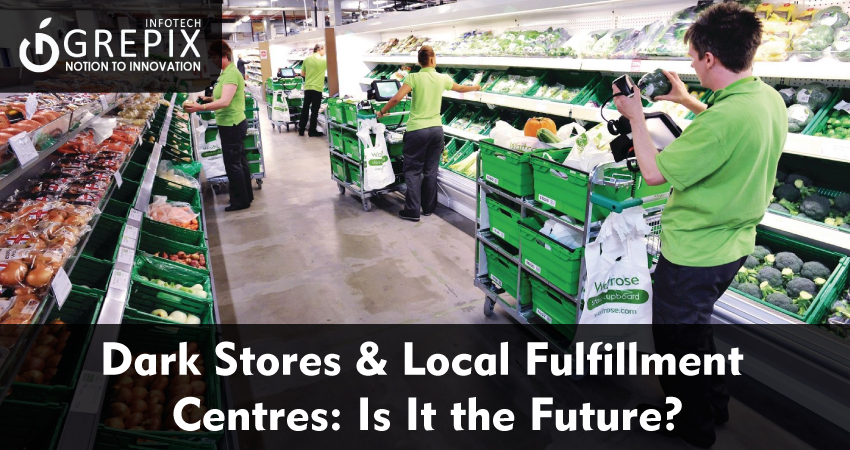Dark Stores & Local Fulfillment Centres: Is It the Future?
The food delivery landscape is rapidly evolving as consumer expectations for speed and convenience rise. Technology-led solutions like dark stores food delivery, local fulfillment centre apps, and next-gen food delivery warehousing are at the heart of this transformation, rewriting how orders are packed, shipped, and delivered. The dark store business model especially is gaining traction, offering hyperlocal delivery with streamlined efficiency. But what are dark stores, and why are they becoming the go-to strategy for the future of food delivery apps and e-commerce.
Consumer demand for quicker, more convenient online shopping is fueling adoption of dark stores food delivery and local fulfillment centre apps worldwide. These technology powered warehousing solutions offer rapid deliveries and cost-effective operations, making them central to the modern dark store business model. As leading companies expand food delivery warehousing with hyperlocal reach, statistics show an explosive market trajectory. Still, the rise of dark stores brings challenges from operational complexity to inventory management and workforce training. In this in-depth guide, learn how dark stores food delivery, local fulfillment centre apps, and food delivery warehousing are shaping the future, explore case studies and statistics, and find answers to real-world questions around the dark store business model.
What Are Dark Stores? [dark stores food delivery, dark store business model]
Dark stores are physical spaces optimized exclusively for fulfilling online orders, rather than serving walk-in customers. These outlets resemble conventional stores but act as mini warehouses, complete with shelves, storage, and staff dedicated to picking and packing. Orders enter via food delivery apps or e-commerce platforms tied to the dark store. Staff pick, pack, and send the items directly for local delivery or pickup.
- The dark store business model originated in the UK in 2009, pioneered by Tesco as a way to meet surging e-commerce demand.
- Today, dark stores food delivery is a key strategy for optimizing inventory, enabling same-day and even 30-minute deliveries.
- Local fulfillment centre apps integrate directly with dark stores, streamlining the entire food delivery warehousing process.
How the Dark Store Business Model Works
- Orders are placed online via local fulfillment centre apps.
- Warehouse workers, not retail staff, pick and pack the items in the dark store.
- Orders are dispatched to customers’ doors often within the same day or even hours.
- The tech-focused layout maximizes workflow, inventory capacity, and speed.
The Role of Dark Stores in Food Delivery
Dark stores food delivery is revolutionizing the last-mile challenge by positioning inventory close to end consumers. Food delivery warehousing, once highly centralized, is now localized for ultra-fast fulfillment.
Technology Integration
- Local fulfillment centre apps coordinate real-time order management, tracking, and delivery.
- Automated inventory systems reduce out-of-stock risk, manage perishable goods efficiently, and boost fulfillment speed.
- Many dark stores utilize robotics, AI-driven picking, and route optimization to further fast-track the food delivery warehousing process.
Benefits for Food Delivery Companies
- Decreased delivery time, often enabling “instant” (sub-hour) order fulfillment.
- Lower operational costs, as dark stores require less retail space and front-of-store staffing.
- Superior scalability retailers can rapidly repurpose low-traffic stores into food delivery warehousing nodes, keeping up with peak demand.
Benefits & Risks: Dark Stores Food Delivery and Local Fulfillment Centre Apps
Key Benefits
- Faster Delivery: Proximity to customers allows dark stores food delivery to offer same-day or hour-level service, increasing satisfaction and retention.
- Smarter Food Delivery Warehousing: Specialized layouts and automation make picking, packing, and inventory management ultra-efficient.
- Reduced Costs: No need for costly store displays, cash registers, or in-person sales staff—just focus on food delivery warehousing and logistics.
- Agility: Easily adapt to spikes in local demand or emergencies like pandemics, making local fulfillment centre apps indispensable.
Common Challenges
- Operational Complexity: Managing workforce schedules, inventory, and automation systems requires advanced technical and logistics skills.
- Setup Costs: Investment in infrastructure, technology, and staff training can be high, especially for major urban networks.
- Inventory Management: Particularly for perishable foods, maintaining optimal stock levels and temperature is crucial.
- Regulatory Barriers: Zoning rules and local regulations can sometimes limit where dark stores can open.
Also Read: Accelerating Your Fortune: Becoming a Billionaire in South Africa's Taxi Industry
Global Case Studies: Dark Store Business Model in Action [dark stores food delivery, local fulfillment centre apps]
Explosive Market Growth
- The global dark stores food delivery market is projected at $30.19 billion in 2025, with an expected surge to $296.77 billion by 2032 a CAGR of 38.6%.
- By 2027, 23% of all retail sales are expected to occur online, further driving dark store adoption.
- In North America, giants like Amazon, Walmart, and Target are using local fulfillment centre apps and food delivery warehousing to reach up to 95% of the US population with rapid delivery.
Leading Industry Examples
- Tesco (UK): Launched the original dark store business model; now runs multiple such locations with seamless food delivery warehousing.
- Amazon (US): Built hundreds of urban micro-fulfillment centers, combining dark stores food delivery with robotics and AI for sub-hour delivery.
- Swiggy Instamart (India): Went from 600 to nearly 1000 dark stores in just a year to meet demand for instant grocery delivery, leveraging local fulfillment centre apps.
- GMR Hyderabad Fulfillment Centre (India): Uses renewable energy and tech to operate a 51,000+ sq. m. warehouse, slashing energy/water use while scaling fulfillment.
User Demographics & Preferences
- 63.3% of food delivery warehousing demand in 2025 is from residential customers, showing households as the chief growth driver.
- Essential groceries form 41.6% of food delivery fulfilled via dark stores worldwide.
The Dark Store Business Model: Future Outlook
The dark store business model is poised to dominate the future of food delivery warehousing and retail logistics.
- Investment in AI, robotics, and automation is set to further cut costs and boost delivery speeds.
- Green initiatives like electric vehicles for delivery and solar-powered operations are emerging as priorities.
- New partnerships with third-party delivery providers and local fulfillment centre apps will expand reach and increase resilience.
Still, for small businesses, the choice between traditional warehousing, micro-fulfillment centers, and true dark stores food delivery depends on order volume, investment capacity, and online growth prospects.
Conclusion
Dark stores food delivery, local fulfillment centre apps, and advanced food delivery warehousing are not just a trend they are rapidly becoming the industry standard. With projected double-digit growth, robust examples from global leaders, and the expectation of instant, contactless delivery from consumers, the dark store business model stands at the forefront of next generation retail and food delivery.
Companies that invest in effective dark stores, cutting-edge local fulfillment centre apps, and responsive food delivery warehousing will be best positioned to thrive. The time to adapt is now: explore automation, strengthen digital delivery infrastructure, and look for opportunities to transform unused physical spaces into powerful fulfillment hubs.
FAQs
1. What is a dark store and how does it differ from a traditional warehouse?
A dark store is set up only to fill online orders and is closed to in-store shoppers, while a traditional warehouse may handle a broad range of logistics tasks and retail supply.
2. What types of products are best suited for dark stores food delivery?
Groceries, packaged foods, everyday essentials, and fast moving consumer goods are top categories, with 41.6% of revenue from groceries alone in 2025.
3. How do local fulfillment centre apps help food delivery warehousing?
These apps route orders, track inventory, and optimize delivery, ensuring efficient coordination between dark stores and last-mile logistics.
4. What are the top risks in the dark store business model?
Main risks include operational complexity, initial setup costs, inventory spoilage for perishables, and compliance with local regulations.
5. Are dark stores a good fit for small businesses?
Dark stores can be effective for businesses with high online order volume, but smaller retailers may find micro-fulfillment centers or third-party logistics providers a better fit to start.







